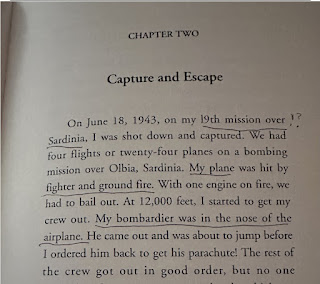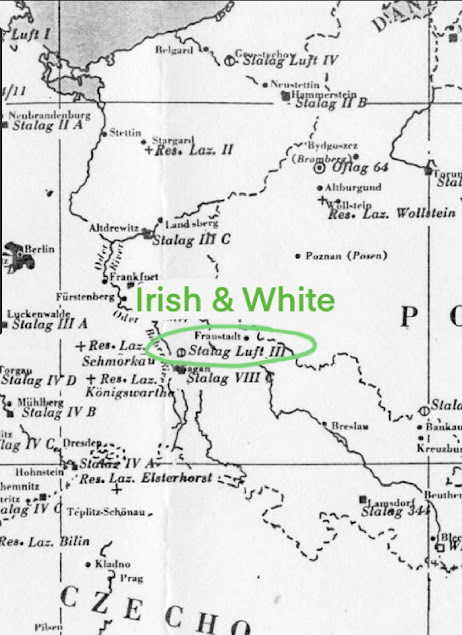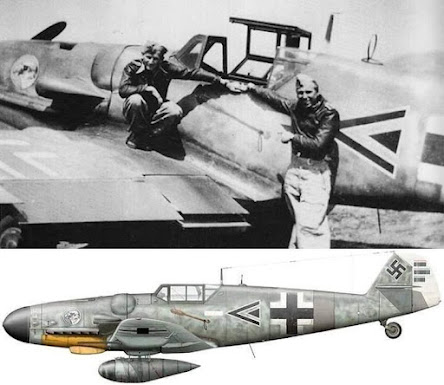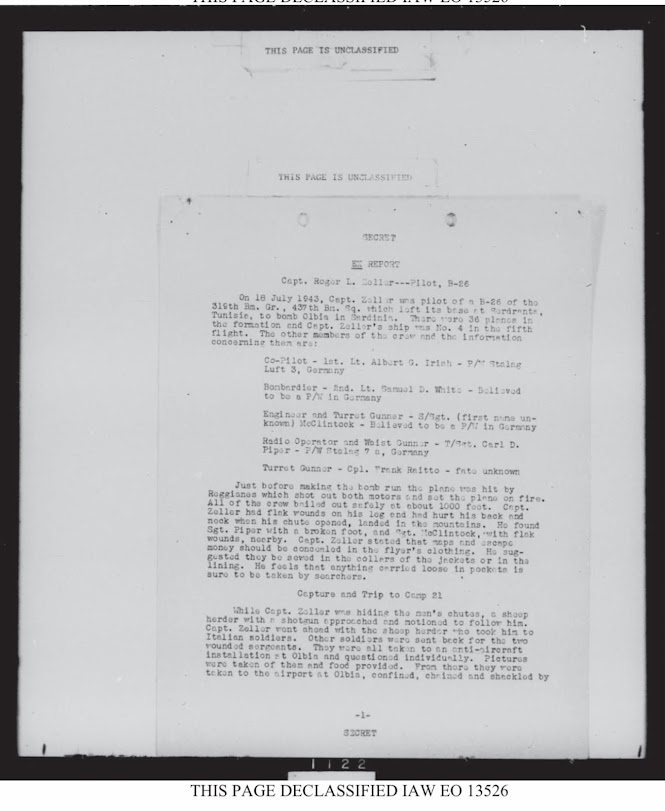June 18th 1943
By Rusty McClintock
Grandson of Engineer/Turret Gunner Sgt. Russel E. McClintock
I haven’t been able to find any photos of B-26 41-31603 either by itself or with the crew.
This is what I’ve been able to piece together about the crew, the aircraft, the timeline leading up to and including June 18th 1943 and what happened to the men after the bomber was shot down. The following information has been gathered from military service records and historical websites, books, ancestry websites and surviving family of the crew.
This is a work in progress and by no means a complete telling of the events and although I hope not, may contain errors. I’ve tried my best to piece it together so it makes sense. If there’s any documents, photos or info you’d like to share to make this a more complete telling, please feel free to email me. Rustymcclintock@att.net
The Crew
1. Pilot - 1st Lt. Roger L. Zeller 0-669439 19th mission
2. Co-Pilot - 1st Lt. Albert G. Irish 0-727220 (unknown # of missions)
3. Navigator/Bombardier - 2nd Lt. Sam D. White 0-664853 14th mission
4. Engineer/Turret Gunner - S/Sgt. Russel E. McClintock 39388728 11th mission
5. RadioOp./Waist Gunner - T/Sgt. Carl D. Piper 6936657 (unknown # of missions)
6. Tail Gunner - Frank A. Raitto 11039915 (unknown # of missions) K.I.A.
(The microfilm above incorrectly lists the wrong aircraft 41-18603 and in fact there is no known B-26 built with that serial number.)
The Aircraft
⁃ Martin Marauder
⁃ B-26B-15-MA (medium bomber)
⁃ Serial # 1941031603 (41-31603)
⁃ Built in Baltimore, Maryland (1 of 100)
The 319th Bomb Group (Medium), 437th Bomb Squadron
Activated June 22nd 1942 at Barksdale Field, Louisiana.
Assigned to the 12th Air Force and 12th Bomber Command September 14th 1942
Entered combat readiness November 14th 1942
Arrived at Maison Blanche Airdrome, Algeria between November 23rd - 27th 1942
The 319th began North African Operations Nov. 28th 1942 flying 29 missions over Tunisia before heavy losses forced temporary retirement of the group for retraining and reorganization.
The groups last mission was February 13th 1943. Nine B26’s took off to bomb El Aouina Airdrome at Tunis. They dropped forty 120lb fragmentation cluster bombs from 10,000 feet and twenty 120 bombs as well. On the return trip they encountered heavy, intense and accurate flak while being attacked by 20-30 German Messerschmitt Bf 109 fighter planes.
Two B26’s shot down by ME109’s
T/Sgt Carl D. Piper credited with the destruction of one ME109.
The group used the time between February 13th and June 1st to rest, retrain and reorganize.
On June 1st 1943 orders were received transferring the 319th to Northwest African Strategic Air Forces under General Doolittle.
Commanded by Col. Joseph R. Holzapple and Major Guernsey I. Carlisle of the 437th Bomb Squadron, they flew to their new base of operations at Sedrata Airdrome, Algeria.
The 319th resumed operations with their first mission on June 5th 1943 against the Sardinian port of Porto Ponte Romano.
For the next 6 days 8 missions of heavy and medium bombers attack the Island of Pantellaria, Italy until their surrender the morning of June 11th. The mission immediately shifted that afternoon to the island of Lampedusa.
June 12th-16th they bombed the western airdromes of Sicily at Trapani-Milo and Bo Rizzo.
Friday
June 18th 1943
Aerial Combat Mission #42
According to Lt. Sam D. White
“The Germans were retreating back to Italy after failing to capture the oil fields in Northern Africa. We were mostly bombing the straight when we were ordered to begin 3 missions bombing military installations with 500lb bombs on the island of Sardinia.”
One report states 31 and another states 36 B-26’s took off that day, 6 at a time in order to reduce the amount of time it takes to catch up to formation. They were the #4 plane in the 5th flight.
1 lost during take off
3 lost during the bombing of shipping, docks and railroad facilities at Olbia, Sardinia.
Just before making the bomb run, the plane was hit by Italian fighter Reggiane, which shot out both motors and set the plane on fire.
From after mission statement
“Ship 41-31603 was behind the formation and trying to catch up. During this time it was under attack by enemy pursuit. Suddenly it started to stream white smoke as if there were large leaks in the fuel tanks. Then, the left engine began to burn and white smoke turned to black. The ship started to turn to the right and started climbing. It pulled to a complete stall and fell off into a spin. Just before hitting the ground it exploded and fell into 3 pieces. During this time at least 3 parachutes were seen to open.”
According to McClintock
“Shot up bad, Lost #1, heavy vibration, full of smoke and fire. Ordered to hit the silk”.
According to Zellers book Seventy Years of Life, Love and Adventure
At 12,000ft Nav/Bombardier White was in the nose of the aircraft and about to jump without his chute. Zeller ordered him back to get it before bailing out.
Co-Pilot Irish was the first to bail out at 10,000ft about 1 minute past the target.
Followed by Turret-Gunner McClintock, Waist-Gunner Piper and Tail-Gunner Raitto at about 8000ft.
White finally bailed out 2 minutes past the target at about 4000ft.
Piper and McClintock reported seeing Raitto’s chute never opening but were able to kept him in their sights during descent. They watched as his chute trailed behind him all the way down to the rocky beach
Irish broke his spine colliding with a tree before hitting the ground.
Piper broke his foot/ankle when landing on the ground.
McClintock had a severe flak wound to the instep of one of his feet. According to his son “Legs not working well, full of flak. Lost consciousness briefly after clearing ship”.
White sustained minor shrapnel injuries during descent. According to his daughter he said “the fires were still raging from the bombing missions as they were parachuting into the mountains”. She recalled “my dad said he hid next to a barn until the local Italians farmers found him. When he heard them approaching he contemplated using his sidearm to put up a fight but thought he’d immediately be killed”.
According to Zellers book, his escape hatch was known to have trouble opening but opened like it had been freshly greased that morning. His chute opened up shortly before hitting the ground after he bailed out at 500ft. After hitting the ground he realized he hadn’t buckled the parachute around his chest. The straps around his legs and waist are what surely saved him. He had flak wounds on his leg and hurt his back and neck when his chute opened and landed in the mountains.
The Italians tracked the men through the sky down to the ground and captured them along with crew from other downed aircraft. They found the body of Cpl. Riatto, and along with injured crew from other downed aircraft they were ordered at gun point to get onto an ox cart on top of their dead crewmates on the Sardinian mountainside. During the trip down the mountain the oxcart toppled over a few times.
McClintock recalled losing his grip trying to hold onto one of the badly injured crew of another aircraft during one of the times it almost tipped over. When the man couldn’t get himself up off the ground the Italians left him behind and it haunted him ever since.
Zeller said they were high in the mountains of Central Sardinia. Two of my crew members landed near me and were severely hurt. Sgt. Piper with a broken foot and Sgt. McClintock with flak wounds. While Zeller was hiding the mens chutes, a sheep herder with a shotgun approached and motioned to follow him. He offered no resistance as he was bruised and bloody. “The sheep herder took me over to an Italian Lieutenant on a motorcycle, who took me into custody”. Other soldiers were sent back for the two wounded Sergeants. They were all taken to an anti-aircraft installation at Olbia and questioned individually. Zeller said “ On the way, we spilled three times on the mountainside, and I was glad to be put into a cell. “
Pictures were taken of them and food was provided.
From there they were taken to the airport at Olbia, confined, chained and shackled by the Italians and underwent a severe interrogation.
On June 19th, under Italian guard, they left Olbia by train and headed to a town in south central Sardinia where all their personal effects were confiscated. There they met several other flyers from the same formation who were split into smaller groups.
On June 23rd, after 4 days of interrogation in a Sardinian jail, with dysentery and malaria, they boarded a 1925 Ford tri-motor aircraft, used as an Italian transport plane, bound for Rome. According to Zeller they flew 50ft above the Mediterranean Sea. They were then taken to Poggio Mirteto is a small town northeast of Rome where the Convent of San Valentino was made into an Italian interrogation camp specifically for Airmen. It was here that they were turned over to the Germans.
Here, the Germans put each of them into solitary confinement where they were interrogated almost constantly. They were only allowed out to use the bathroom and often had to urinate on the bare stone floor they slept on and they were denied cigarettes in an effort to make them talk. The Germans clearly did not abide by the Geneva convention.
They found warnings carved into the underside of wooden chairs such as “beware - microphone in ventilator in ceiling”. The warnings were confirmed by a guard who disliked Mussolini and traded them bread for English lessons. After those 11 days of unsuccessful interrogations they were put in rooms together and the Italian Commandant became a “fourth at bridge” with Zeller and two others, Lt. John S. Van Epps and a B-17 pilot.
PoW Camp
After 11 days at Poggio Mirteto Piper, McClintock, Irish and White were transferred out to PoW camps in German territory that housed airmen.
On July 10th, after 17 days Zeller, the pilot, was transferred from Poggio Mirteto to Prigione di Guerra (Campo) P.G. 21 Concentration camp, an Italian prison camp located in the town of Casoli near Chieti, Italy.
Co-Pilot - 1st Lt. Albert G. Irish
Bombardier - 2nd Lt. Sam D. White
Sent to Stalag Luft III (Airmen camp) in Sagan-Silesia Germany.
As a result of Albert Irish’s injuries, he was transferred from Stalag Luft III to a PoW hospital camp. He stayed there until the Germans released him in a prisoner trade along with 19 other PoWs. He eventually made it to Lisbon, Portugal where he boarded the Swedish-American ship The Gripsholm bound for New Jersey and expected to arrive March 14th-15th 1944. According to a letter he wrote titled Testimony From Front dated August 11th 1944, He was then transferred to Birmingham General Hospital in Van Nuys, California for treatment on his spine. BGH was used a military hospital during the war.
Sam White spent over two years in Stalag Luft III. According to his daughter Sam was into HAM radios since he was a young boy and was trying to make one out of parts he found in camp. On Jan. 27th 1945 the prisoners were force marched in the freezing winter, with very little clothing, to Muskau (1) then to Spremburg (2) on Jan. 31st. From there they were loaded up and locked into unmarked freight cars, 50 men to a car, for a 2 day trip to Stalag VIIA in Moosburg(3).
On Feb 2nd they were forced to march 2 more days to Stalag 13D in Nürnberg(4) (Nuremberg). They had very little food or supplies and the camp was in very bad shape. It was infested with lice, fleas and bedbugs. On April 3rd 1945 they were told to evacuate to Stalag XIIID . They began marching April 4th to Newmark(5), then Bersheim(6), then to Mulhauser(7). They reached the Danube on April 9th and finally reached Moosburg (8) April 29th. General Pattons 3rd Army liberated the camp the morning of April 29th 1945. Sam said in the end, the SS came to run the camps, the German Civilians were starving and when the camp was liberated he was 6 feet tall and only weighed about 100lbs. He said they were afraid to take showers as word had gotten around about the gas chambers.
Engineer/Waist Gunner - T/Sgt. Carl D. Piper known to McClintock as C.D. Piper
Radio Operator/Turret Gunner - S/Sgt. Russel E. McClintock PoW# 112679
Sent to Stalag Luft VIIA (7A) Moosburg
On Oct. 13th 1943 they were transferred from Stalag Luft VIIA to Stalag XVII-B (17B) near Krems, Austria and held there till April of 1945.
On 8 April 1945 4,000 of the Stalag 17B PoWs began an 18 day march 281 miles to a Russian prison camp north of Braunau, Austria. The remaining 200 men were too ill to make the march and were left behind in the hospital. The men who stayed behind were liberated by the Russians on May 9th.
Food was very scarce and upon arrival at the Russian prison camp, the POWs cut down pine trees and made small huts since no housing was available. The grounds and nearby woods were patrolled by roaming guards and few escape attempts were made since it was apparent that liberation forces were in the immediate vicinity.
On May 3rd 1945 the camp was liberated by 6 men of the 13th Armored Division. They arrived in 3 jeeps and had no problem in capturing the 205 remaining guards. Other units of the 13th Armored Division followed shortly and organized the evacuation of the POWs by C-47s to France on May 9th 1945.
Pilot - 1st Lt. Roger L. Zeller
P.G. 21 Concentration camp was overcrowded with little running water, poor sanitation, shortage of food, no heat and was known as one of the worst, most brutal camps in Italy.
When the Italian armistice was announced the camps guards were removed and the prisoners ran the camp. The Germans established a kind of “protective custody” over the camp and on Sept. 23rd the American officers were taken in trucks from Camp P.G.21 to Sulmona where they started the process of shipping the prisoners to Germany by train.
They arrived at a temporary holding facility at Sulmona at 1200 hours. Determined not to go to Germany, Van Epps persuaded Zeller to join him in an attempt to escape. They spent the afternoon looking over the place with the idea of escaping that night.
At 8pm (2000 hours) Zeller and Lieutenant John S. Van Epps crawled through the barbed wire above a wall behind the latrine, into a courtyard, over another wall and made their way 5 miles from the camp, where they hit out in the mountains. They traveled by night and hid by day while hiking obscure mountain trails and traveling with refuges from Rome.
They finally took refuge in the shack of a mountain charcoal burner where they stayed for 9 days stayed 9 days. Expecting to hear news of the allied advance from the second day on they were in civilian clothes which they had obtained from friendly civilians. A German soldier stopped to look at them and then kept walking.
On October 14th Zeller and Van Epps came to a farm house in the hills just outside Trivento where they were taken care of by an American woman who is married to an Italian man who was the owner of the farm. She was a polish woman named Mary Nieman, who met her husband while in college in Chicago. Zeller reported that she had taken care of more than 80 American escapists by aiding them with food and money. He described the farm as being about 10 to 15 acres in size and also stated that the husband, Giovanni Niemann was leading parties of American and British escapists through the battle lines.
Zeller and Van Epps stayed at the farmhouse over night and upon directions furnished by the woman they left on October 15th. Guided by a local man (possibly her husband) they crossed a river into Allied territory through the only break in the line which was an inactive sector located between two centers of resistance. They joined British lines at Casacelanda on October 16th 1943. From Casacelanda, Zeller and Van Epps were relayed back to the British 8th Army and then returned to their base. They spent 24 days behind enemy lines before they returned to their unit October 22nd 1943.
According to a report
On Oct. 22nd 1943, They were referred to as “shades of the past” and “ghosts from way back”. The report tells how they calmly walked through camp, startling old cronies and telling stories of their time behind enemy lines.
Zeller was soon transferred back to the states where he arrived at Newport News, Virginia November 15th 1943.
Tail-Gunner - Cpl. Frank A. Raitto
Was killed in action during the bombing mission when his chute failed to fully deploy.
His body was never recovered by Allied forces and is listed as KIA/LAS (Killed In Action/Lost At Sea)
His name is carved into a stone monument in the Florence American Cemetery in Via Cassia, Florence, Italy.
Report
“The raid on June 18th on shipping, docks and rail road facilities at Olbia, Sardinia, was the only exceptional one of the 3 (missions). The enemy used all its power to disperse the attack by severely pounding the formation with intense and accurate flak and sending up 5 waves of fighters to deter the bombing. 2 waves attacked en-route to the target, 1 over the target and 2 more after the target continuing their passes until the formation was south of Sardinia. Despite the loss of the bombers and crews the mission obtained an excellent concentration on the target and General Doolittle congratulated the group.”
What a cost for freedom.
Albert G. Irish would return to Los Angeles where he married Marjorie Hodges in a Hollywood ceremony and together they had a daughter.
He would pass away suddenly while in his garden in 1960 at the age of 39.
This is the only photograph I’ve been able to find of Albert
My grandfather, Russel E. McClintock would return to the states after the war but remain in the military. When the Air Force separated from the Army he had to endure boot camp all over again. He bounced around the world to different Air Force Bases he was assigned to and earned secret clearance when he became a minuteman guided missile technician until he was honorably discharged Oct. 31st 1965.
He passed away 1973 at the age of 54.
He and his wife, Katherine had a son, Russel E. McClintock Jr. born in Oct of 1942.
Sam D. White returned to his wife Amy in Texas. They had 3 children together.
Sam lived a long life and passed away in December 2013 at the age of 92.
No photo available
Carl D. Piper, known to my grandfather as C.D. Piper married Betty J. Hewitt in Washington State in September of 1945. They had 3 children together.
Carl passed away in July of 2002 at 81.
No photo available
Roger Zeller was transferred to the Pentagon in 1944 as a staff member and was also a B26 flight instructor. He provides a photo in his book of his aircraft he used while teaching that he named “Cherry Blossom” after his wife Laura “Cherry” Zeller. He was discharged in 1946 but was recalled to active duty during the Korean War. He was discharged from duty again in 1953 but remained active in the reserves and in 1962 became Brigadier General.
Zeller founded Columbia 300, the world’s largest producer of bowling balls, was inducted into the Bowling Hall of Fame, and was responsible for bringing the NBA to San Antonio, Texas. He was an owner, officer and director of the San Antonio Spurs for 16 years.
He passed away in 1997 at the age of 80.
He and his wife left behind a charitable foundation and few scholarships.
The Roger L. and Laura D. Zeller Charitable Foundation which has provided grants to healthcare, nursing and cancer research and also helped fund a wing of the Cancer Therapy and Research Center in San Antonio.
He also established the Columbia 300 John Jowdy Scholarship Fund. A scholarship for Senior year high school bowlers.
The Brigadier General Roger L. Zeller scholarship fund was established by the Falcon Foundation which provides grants for United States Air Force Academy students.
(Photo of the aircraft Zeller used while he was a flight instructor)
Stalag Luft III, the camp where 1st Lt. Irish and 2nd Lt. White were prisoners, was depicted in the 1963 film The Great Escape starring Steve McQueen.
There are a couple websites who credit Luftwaffe Pilot Hptm Karl Rammelt with shooting down the aircraft but there is no hard evidence/documentation showing this.
These last two screenshots provide the most detail I’ve found of Rammelt claiming a victory against a Marauder but doesn’t specifically list 41-31603.
Therefore I believe credit belongs to the Italian fighters according to this report dated Dec. 9th 1943.
I’ll continue to update this blog as I gather more information.
I also want to add all of my source material to the bottom of this entry.










































No comments:
Post a Comment